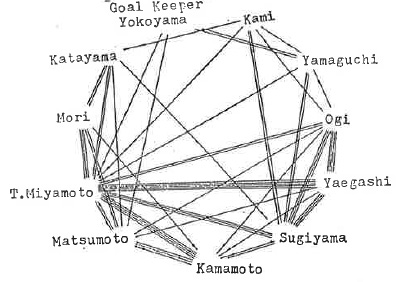| |
|
|
サッカーマガジン 1970年3月号 |

|
The Goal-Post Murder Case
On three separate occasions in a period of one month ending on January 16, a boy was struck on the head and killed when nearby goal-posts collapsed. All three, aged12,14 and 15 years respectively, were Middle School pupils of Tokyo and Kawaguchi City, which is 16 miles from Tokyo. In each case, the offending structures were made of light steel pipe and were not embedded in the ground. In one case, a strong gust of wind blew the goal down,and a boy playing near it was crushed by the crossbar, while in the other two cases, school team players became victims during training sessions.
The Emperor's Cup
Toyo Kogy F.C. of Hiroshima, who had been League Champions for four successive seasons since 1965, recovered from the humiliation of losing the league title in the1969 season, by winning the Emperor's Cup. The top four teams of the Japanese Soccer League and the University Tournament took part in the competition, and Toyo Kogyo, Runners-up in the League, beat Rikkyo University 4−1 in the Final at the Olympic Stadium in Tokyo on New Year's Day. The new League Champions, Mitsubishi F.C. of Tokyo, had been eliminated by Rikkyo in the Semi-Final. |
|
Scientific Study of Football Matches
How many miles does a player run in a football matcha? How many times does a player take part in a move? The Japanese Football Association can answer these questions.
The Association has formed a standing committee to study the game in all its as'pects. This committee is made up of specialists in the fields of education, psychology,physiology etc.
According to the report, the average distance covered by a player in any match of 90 minutes' duration, is 4.5 miles (7,200m)., and the longest distance on record is one of 12,391m., covered by Masopust of Czecho-Slovakia in 1968 1n Tokyo.
‘Participation frequency,’ the number of times a player actually plays the ball, averages out at 50 per match. Naturally, in every team, the ‘link-man' averages a higher number than anyone else, and in Japan, Yaegashi holds the record of 114, which he set up in the match against Korea in 1967.
The committee has also developed a new system to show the move-by-move composition of a football match, and the following diagram. drawn from the game between Japan and Korea in 1967, reveals the direction and frequency of passes made amongst the eleven members of the Japanese team.

|
|
|
■

|
|